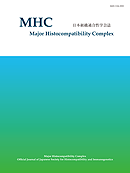
- Issue 3 Pages 158-
- Issue 2 Pages 98-
- Issue 1 Pages 42-
- |<
- <
- 1
- >
- >|
-
Chieh-Wen Lo, Yoko Aida2022Volume 29Issue 3 Pages 158-167
Published: 2022
Released on J-STAGE: December 20, 2022
JOURNAL FREE ACCESSThe major histocompatibility complex (MHC) of cattle is known as BoLA and located on chromosome 23. It was found that BoLA shows significant differences in genome organization with human MHC but shares similar protein structures and functions. Among the entire BoLA class II subregion, BoLA-DRB3 is the most polymorphic and functional gene that has been intensively studied its correlation with various cattle infection diseases and economic traits. In particularly, BoLA-DRB3 polymorphism has been linked to resistance or susceptibility of bovine leukemia virus (BLV) infection outcome, transmission and disease progression. BLV leads to enzootic bovine leucosis which is the most common neoplastic disease in cattle and leads to severe financial loss in industry worldwide. As a result, genetic selection of BLV-resistant animals, as well as the preferential culling of BLV-susceptible animals, based on BolA-DRB3 polymorphism, serves as a promising strategy for the control of BLV spreading and disease risk estimation, especially in the time there are no vaccines and treatment available. In this review, we outline the BoLA system in protein and genetic levels and focus particularly on the literatures of association between BoLA-DRB3 polymorphism with BLV.
View full abstractDownload PDF (1770K) -
Makoto Iwasaki2022Volume 29Issue 3 Pages 168-174
Published: 2022
Released on J-STAGE: December 20, 2022
JOURNAL FREE ACCESSThe immunological effect of human leukocyte antigen (HLA) disparity has not been fully elucidated by the number and locus of HLA antigens or alleles. Recent progress in Graft-versus-host disease (GVHD) prophylaxis including post-transplant cyclophosphamide enabled us to select HLA mismatched donors as alternative therapeutic options. Donor selection strategies based on HLA mismatching patterns under the recent prophylactic strategy are still in active discussion. Based on accumulated knowledge about amino acid sequences, structures of HLA molecules, and their interaction, several methods to predict epitopes recognized by the immune system have been developed to understand the immunogenicity of amino acid sequences in mismatched HLA pairs. Several reports showed the importance of HLA epitope mismatching on outcomes including neutrophil engraftment, GVHD, and relapse after hematopoietic stem cell transplantation. In this review, we would like to discuss the importance of HLA epitope matching in hematopoietic stem cell transplantation.
View full abstractDownload PDF (334K)
- |<
- <
- 1
- >
- >|